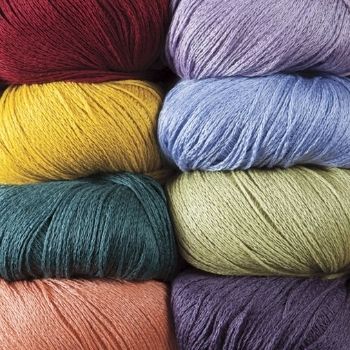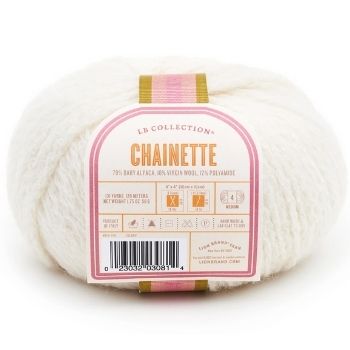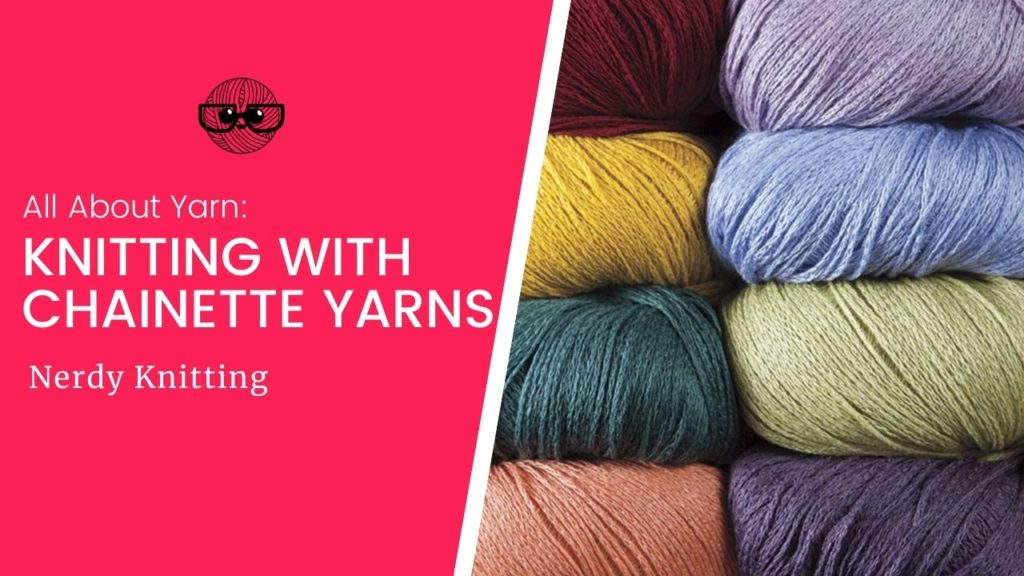Chainette yarns (also called chained yarns) are a wonderful additional to the modern knitting world. When you look at one of these yarns, you’ll immediately notice how different their appearance is to regularly plied yarns – they look like little pre-knitted cords and braids.
In this article we’ll explore everything you need to know about knitting with chainette yarns, including:
- What is Chainette Yarn?
- Properties of Chainette Yarn
- Knitting with Chainette Yarns
- Where to Buy Chainette Yarns
Let’s dive into each of these topics so you’ll know when you should give this interesting yarn construction a try.
Image Credit: Knit Picks
Some links below are affiliate links. If you click through and make a purchase I may receive a small commission at no extra cost to you. See the disclosure policy for more information.
What is Chainette Yarn?

Standard yarns are usually made by carding, combing, and spinning fibers into singles. These singles can then be twisted (plied) together in any combination or number. The plying process can vary from one yarn to the next – one might not be plied at all and remain a single, two or three might be plied together, or even two plied singles might then be plied together with another pair of plied singles.
Chainette (or chained) yarns take very fine yarns that have been plied together and use some unique construction methods instead of the standard plied method. They may be made by braiding the singles or fine plies together instead of twisting them. Or some chainette yarns take those finely plied strands and actually make small, pre-made I-cords.
If you look at the yarn pictured here (Knit Picks Lindy Chain) you can see the small chain-like strands of yarn.
These braids and cords are really just a hollow tube, making chainette yarns that are very lightweight (even if the fibers used to create the yarn aren’t very light). This construction method is great for plant fibers that tend to be heavy and inelastic. It’s also really good for short staple fibers that are more difficult to spin into useable yarns.
Properties of Chainette Yarns
Every chainette yarn is different because the fibers used in the yarn add their own unique properties to that specific yarn. But all chainette yarns share some unique traits.
They are light, elastic, and strong – even if the fibers used to create the chainette yarn aren’t particularly light, elastic, or strong. Because the braid or cord is simply a hollow tube, it’s very light and, like many types of braids and cords, has some built-in elasticity. The structure of this chainette tube also adds additional strength (even to very weak fibers).
Because of the hollow center, they are also very warm. Heat travels into that hollow core and is trapped there – adding some nice warmth to a project.
These types of yarns are also less expensive – because it takes less of the fiber to create the yarn (it’s just a hollow tube after all) and isn’t prone to pilling (because the fibers are locked together in plies and then braided or knitted into a small tube).
The one slight drawback is that the stitches with a chainette yarn aren’t as clear and crisp as a tightly spun plied worsted yarn. So if you are looking for a yarn that has superb stitch definition, these aren’t quite as good as a standard worsted plied yarn but they can still work – depending on the particular yarn. Some chainette yarns have a fuzzier appearance than others. As in any knitting situation, swatching will show you exactly how the yarn will ultimately behave in your finished garment.
Discover the Confidence You Need to Fix Your Knitting Mistakes

By the end of this six-part self-paced course, you’ll be able to read your knitting, recognize a variety of knitting mistakes, and understand how to fix them.
Knitting with Chainette Yarns
Chainette yarns often take fibers that are difficult to knit with or hard on the hands (especially inelastic fibers like cotton) and make them much easier to enjoy. If you’ve ever knit with cotton you may notice that your hands are tired after awhile. That’s because cotton has no elasticity and it creates more pressure on your hands as you’re knitting. But when cotton uses a chainette structure, the construction of the yarn adds some elasticity to the fiber – making it so much easier to knit.
This construction is now commonly used for plant fibers – all of which lack elasticity (and are usually heavier than animal fibers) so they tend to droop and sag over time. When those fibers are plied together in a chainette construction, the resulting yarn has all of the elasticity and lightness that the fibers they are made from lack. This makes them a wonderful choice for summer garments – the plant fibers are naturally cool and drape well and the chainette constructions adds lightness and elasticity to your summer knitted garments.
Generally, you’ll want to use a larger size needle than you would for a traditionally-plied yarn – to give the yarn room to stretch.
It’s very important to swatch with this type of yarn – especially if you’re considering using it for a pattern that uses a more traditionally constructed worsted spun yarn. You’ll need to check your gauge to determine if it’s a proper substitute – but it varies from pattern to pattern and yarn to yarn.
These types of yarns may also tend to ‘bloom’ after washing (depending on the fibers used in the construction of the yarn) – so this makes taking careful measurements (before and after washing) especially important.
Joining Chainette Yarns

When you’re knitting with this yarn you may notice that it’s not as easy to use some of the standard yarn joining techniques – magic knots can look bulky, Russian joins look very thick, you can’t really separate the plies and splice them together, and if it’s made from plant fibers you can’t felt the ends together. Instead, you may just have to resign yourself to weaving in the ends as you go or when your project is finished.
But sometimes (especially if your project has a lot of open space) those ends are still noticeable, even after being carefully woven in. I found two different methods for joining the ends (so you can avoid weaving in all those yarn tails when you’re done).
One option for thinner chainette yarns is to overlap the edges of the two yarn tails and sew them together. This article from Quince & Co demonstrates how they use this method for their linen Kestrel yarn.
This YouTube video from Skacel demonstrates a second option – hiding the tails right in the center of hollow core of the chainette yarn.
Substituting Chainette Yarns
If your pattern calls for a chainette or chained yarn and you want to substitute a more traditionally plied yarn, you’ll have to consider the other factors – especially fiber content. Chainette yarns are used to add strength, elasticity, and lightness to heavy yarns. So, for example, you can’t directly substitute a 100% cotton worsted yarn for a 100% cotton chainette. They are going to feel very different and they are going to have different weights – resulting in a very heavy garment.
Instead, look for a yarn that has a similar weight as the original so you are still using something that has a lightness to it (specifically the put-up ratio of the yarn – the weight of the actual skein should be comparable to the original) as well as choosing one that fits in the same standard weight system (worsted, DK, etc).
Substituting a chainette yarn for a more traditionally plied yarn that a particular knitting pattern calls for is actually much easier. Choose one that fits within the same standard weight system (DK, sport, etc), has similar fiber content to be as close to the original as possible, and has a similar put-up (the weight of the actual skeins should be comparable).
Of course there is much more to consider when substituting yarns – learn more about the basics of yarn substitution in this article.
Where to Buy Chainette Yarns
Chainette and chained yarns are getting more popular and more yarn brands are using this construction method. While it’s often used for plant fiber yarns that lack their own natural elasticity and can be quite heavy, this unique construction is also being used for animal fibers.
Plant Based Yarn Blends

Chainette yarns that use a variety of plant-based materials as the fiber source for the yarn are a great choice for summer tops and tees. The construction adds some lightness, elasticity, and strength to heavy, inelastic plant fibers. Here are a few recommendations for chainette yarns that use plant fibers:
- Knit Picks Lindy Chain (linen & Pima Cotton)
- Bergere de France Pur Coton (100% cotton)
- Premier Yarns Home Cotton (cotton & polyester)
- Stacy Charles Fine Yarns Nina (linen & cotton)
- Shibui Knits Reed (100% linen)
Animal Fiber Yarn Blends

While chainette yarns using plant fibers are becoming a staple in the knitting world, you can find animal fiber blends as well – especially with animal fibers that lack their own natural elasticity (like alpaca) or short-staple fibers that can be hard to spin on their own or be more likely to pill – all of this is minimized or eliminated with a chained yarn construction. Here are a few yarn recommendations for animal fiber chainette yarns:
- Lion Brand LB Collection Chainette Yarn (baby alpaca, virgin wool & polyamide)
- Debbie Bliss Paloma (baby alpaca, Merino wool)
- Berroco Catena (Merino wool & nylon)
- Juniper Moon Farm Fourteen Paints (Merino wool & cashmere)
- Lana Grossa Alta Moda Alpaca (alpaca, wool & nylon)
Other Chainette Yarn Blends
While plant and animal fiber blends are both common, there are some more that combine the two types of fibers. You’ll also find chainette yarns that use synthetic fibers as well. Here are a few examples:
- Debbi Bliss Sita (silk, cotton & polyamide)
- Paintbox Yarns Metallic DK (cotton & polyamide)
- Red Heart Ombra (acrylic, wool & nylon)
- Plymouth Yarn Viento (baby alpaca & bamboo)
- Lang Yarns Cashmere Cotton (cashmere & cotton)
Now that you know all about chainette yarns, you’re ready to knit a project with this type of yarn. If you’re looking for more information on various yarns and fibers for knitting, take a look at the resources and articles linked below.
More About Yarns & Fibers
- The Knitter’s Book of Yarn by Clara Parkes (available at Amazon)
- Yarn Substitution Made Easy by Carol J. Sulcoski (available at Amazon)
- The Fleece & Fiber Sourcebook by Carol Ekarius & Deborah Robson (available at Amazon)
